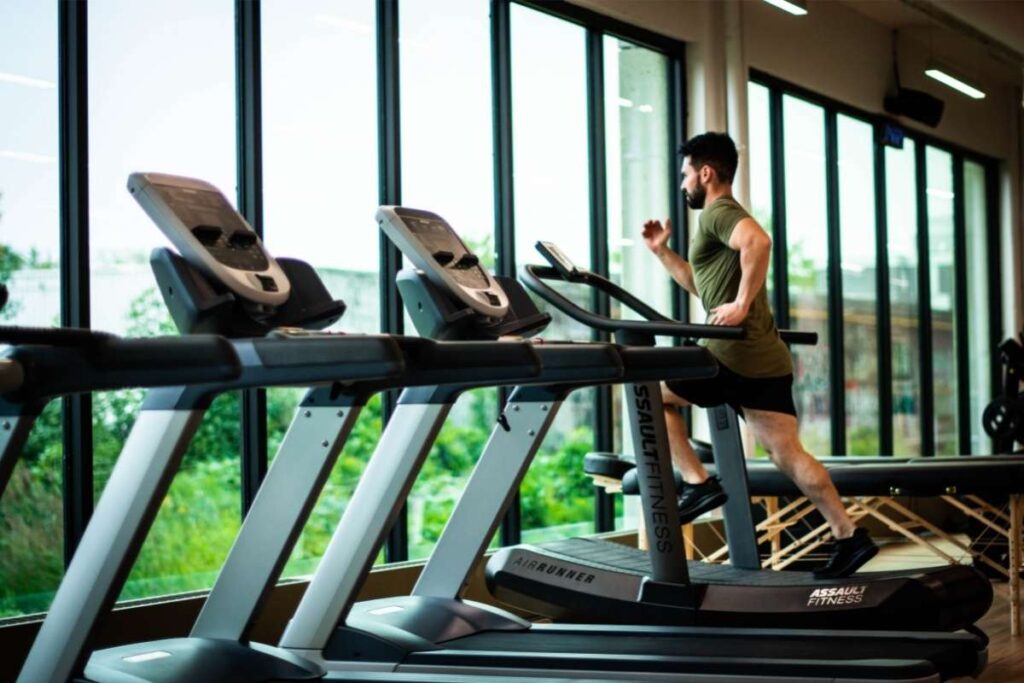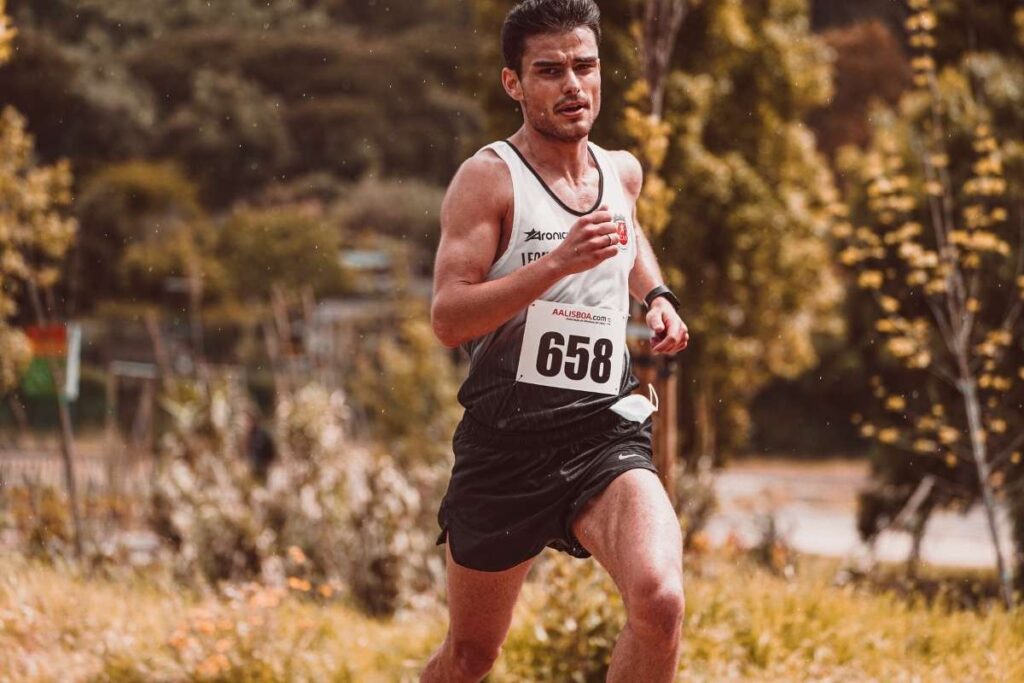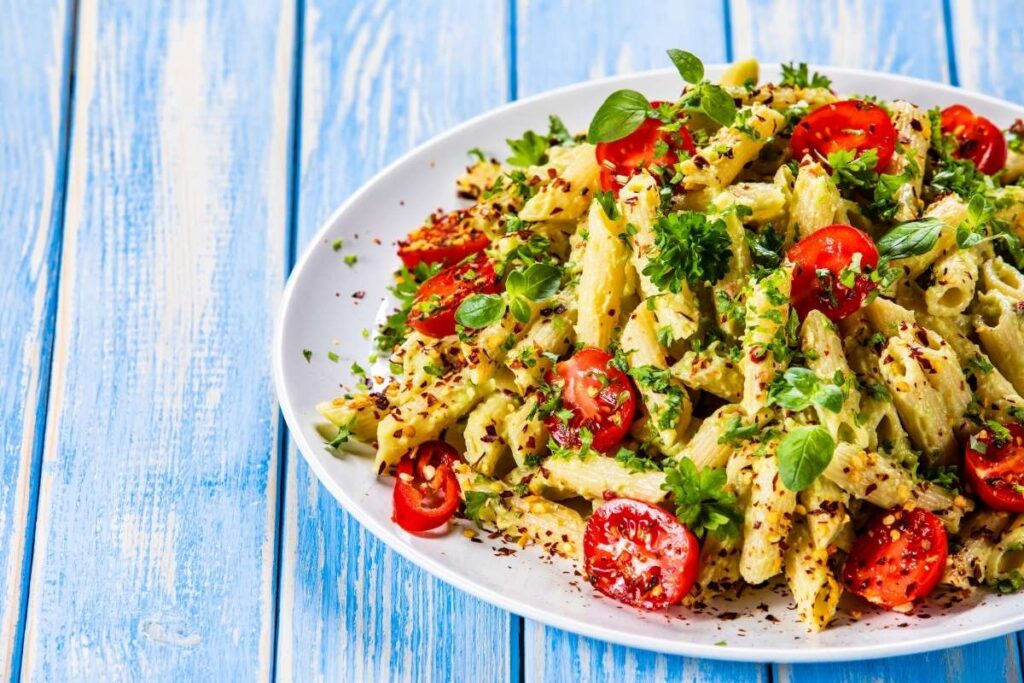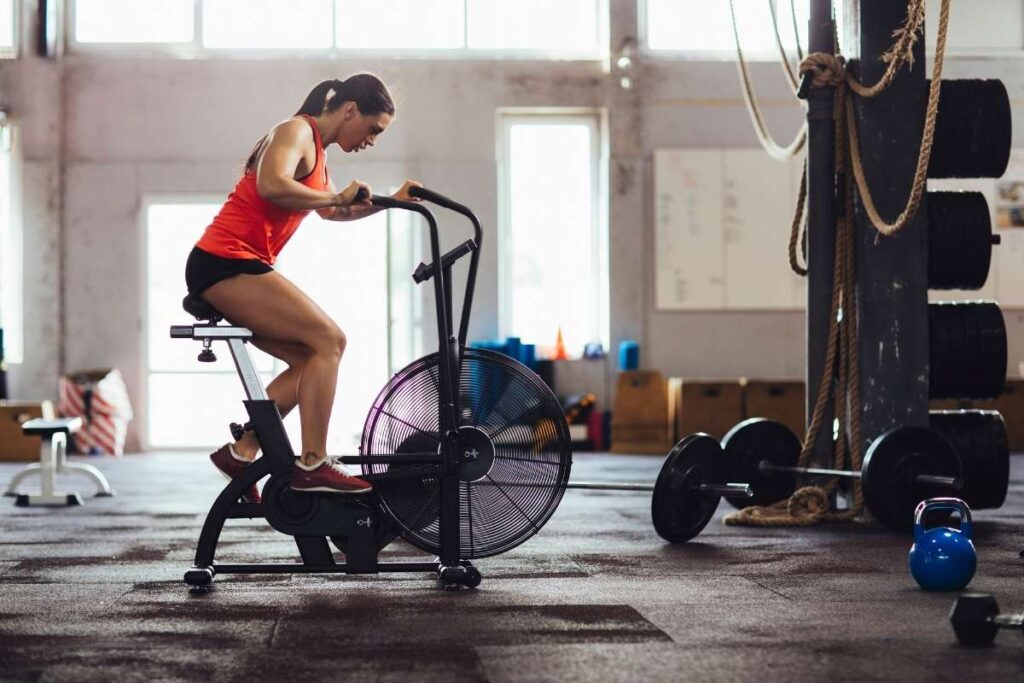This post may contain affiliate links at no additional cost to you. As an Amazon Associate I earn from qualifying purchases. Click to view our full disclosure.
What's inside
Does cardio burn muscle?
Most of us go to the gym to build muscle, but many of us also want to be lean and healthy. Naturally, one of the best ways to do this is with cardio.
But won’t the cardio kill your gains?
This question has plagued many lifters for years. It leaves many of us to wonder if it’s worth having cardio fitness at the cost of looking jacked.
Today, I will answer the question, “Does cardio burn muscle?” with science. I’ll help you understand the best plan of attack to get you fit and keep your physique.
Let’s dive in.
Does cardio burn muscle?
Related: Hypertrophy Vs Strength Training

No, cardio does not burn muscle. However, the type of cardio, plus the frequency and duration of training, may affect your gains.
Research has identified that aerobic exercise can in fact aid in muscle hypertrophy.
A study examining cardio on older and younger subjects over the course of 12 weeks found that aerobic exercise training aided in muscle hypertrophy of the quadriceps.
The exception comes when discussing the type of cardio you perform. Muscle hypertrophy typically requires a calorie surplus. If done wrong, cardio may be usurping the calories required for muscle growth.
Further research identified an increased volume of endurance training would result in interference with muscle hypertrophy.
Cardio such as steady-state cardio is linked to type-1 muscle fiber stimulus, which is opposite to the type-2 fiber stimulus required for muscle growth.
Science has also identified that sprint-based training combined with strength training yields no reduction in muscle strength but will improve VO2 max. VO2 max is the maximum amount of oxygen your body can use during exercise.
What are the common signs of muscle burning?
The common signs of muscle burning and decreased muscle size from cardio training are fatigue, overtraining, poor performance, and reduction in strength.
Why does cardio burn muscle?
Related: 16 Best Low Impact Cardio Machine
The effects of cardio on muscle mass are the result of stimulating opposing muscle fibers.
Cardio requires improvements to type-1 muscle fibers, while hypertrophy requires the stimulus of type-2 muscle fibers.
When you perform cardio for a longer duration and higher frequency, the body must use the energy surplus to fuel the body.
This reduces the calories from the calorie surplus required to fuel muscle hypertrophy.
When there is insufficient fuel for the body, our body will likely fall into a calorie deficit. This naturally results in a decrease in muscle mass.
Can’t decide which cardio is right for you? Check out the Best 14 Stairmaster Benefits: Workouts For Cardio, Glutes, And Fat Loss
How can cardio burn muscle?
Related: Does Running Burn Belly Fat?

Below is a list of why there may be a reduction in muscle size from cardiovascular exercise.
Too Much Cardio
Increased frequency of cardio will burn more calories. Calories are vital for building quality muscle mass.
When we perform cardio regularly, the surplus of calories that we require to promote muscle hypertrophy is used to fuel our running.
This leaves little left over for muscle growth.
To reduce the effect your cardio has on muscle growth, reduce the frequency to two to three times per week or simply on your off days.
This will drastically reduce the amount your body burns while providing the necessary recovery for muscle growth.
Cardio Session Are Too Long
Cardio duration can also be a muscle mass killer, as the longer we perform cardio, the more calories we burn.
To avoid burning precious surplus calories, consider reducing your cardio session time. Stick to 15-20 minutes of high-intensity sessions, such as sprints or intervals.
Sprinting stimulates type-2 muscle fibers, similar to resistance training.
As we learned, performing high-intensity or sprint-based training in conjunction with strength training has been shown to not only maintain muscle mass but increase VO2 max.
This way, you’ll still be getting the benefits of cardio training while not sending yourself into a calorie deficit.
High Impact Training
High-impact cardio training may affect your ability to build and retain muscle mass.
The impact of running can be more detrimental to muscle, as running is an eccentric dominant movement. Eccentric dominant movement is linked to greater tissue damage.
Greater damage, combined with less recovery, may show decrements in hypertrophy and strength.
With this in mind, try low-impact cardio such as cycling, elliptical, or rowing machines. These are more concentric-focused.
Overtraining
In general, overtraining can affect muscle growth. When you overtrain, you’re reducing the appropriate recovery time required for muscles to develop.
The research identifies that scheduling aerobic and resistance training too close together is not optimal for neuromuscular and aerobic improvements.
This results in impaired adaptations to both strength and endurance.
To get the most out of your training, consider performing your cardio and resistance training on separate days.
This will allow your body to perform at a higher intensity during each session while giving you the rest required to improve both muscle mass and cardio fitness.
Poor Nutrition
Poor nutrition is one of the fastest ways to decrease performance and impair muscle growth.
As established, we can’t build quality muscle if we’re burning more calories than we are taking in. The body will begin to burn fat and fuel stores.
When participating in cardio and resistance training, we need a calorie surplus to fuel our session.
The current daily recommendation is 2,500 calories for men and 2,000 calories for women. A calorie increase of 15% is required for muscle hypertrophy.
An even greater surplus is required to sustain muscle mass and continue muscle growth while fueling the body for intensive cardio exercise.
Insufficient Protein Intake
Insufficient protein intake can lead to poor muscle growth and a decrease in current muscle mass.
To ensure you’re getting the most out of your weight training, research recommends you consume 1.6g-2.2g per kilogram of body weight for muscle hypertrophy.
This will help you build and maintain muscle mass and recover from intense exercise sessions.
Exhausting Cardio Before Lifting Weights
The order of your exercise should be based on your primary goal.
Performing an exhausting cardio session prior to your weights session is another way to decrease muscle size.
When you perform your cardio before weights, you burn some of that excess energy that may be vital to maximizing your lifts.
The cardio component here not only burns through your calorie surplus but also fatigues the muscles that you’re supposed to use to perform your lifts.
If you want to build mass, you should focus on your resistance training session first. This way, you can focus on lifting heavy to promote muscle hypertrophy. Finish off with a cardio session, or maybe better yet, save it for another day.
How to do cardio without losing muscle?
Related: How To Gain Weight In Buttocks And Thighs?

To perform cardio without losing muscle, consider performing high-intensity sprint or interval sessions for a shorter duration.
By performing them at higher intensities, you’ll stimulate type-2 muscle fibers similar to those used in resistance training.
Also, perform them on alternate days with a moderate level of resistance or low-impact alternative activity.
This will allow you to get the benefits of increased VO2 max, stimulating muscle fibers, without further damaging muscle tissue.
Need some extra fuel to help maintain mass when performing cardio? Check out A Healthy 3,000 Calorie Meal Plan With PDF
Pro Tips to Avoid Losing Muscle While Doing Cardio
Related: Top 10 Low Impact Cardio Exercises

Here is a list of pro tips to help you reduce losing muscle from cardio.
Eat Calorie Surplus
If you decide to take up a cardio routine as a part of your training, be sure to increase your calories.
Both cardio and resistance training can be demanding on the body. Combining them will require a lot of energy.
A calorie surplus of 3,000 for men and 2,500 for women should be considered as a minimum.
Eat High-Quality Carbohydrate Foods

When undertaking a cardio routine, it is vital that we fuel our body with the correct macronutrients to get the job done.
On top of protein to build and maintain muscle mass, you will need quality carbohydrates to fuel your body before and after your workouts.
Research suggests quality carbohydrates before aerobic sessions improved performance.
Also, consume carb-rich foods such as pasta, grains, vegetables, and fruits post-workout. These can be quickly absorbed to replenish glycogen stores.
It will provide you with the energy required to perform and effectively recover.
High-Protein Diet
Related: 14 Best Protein Powder Without Artificial Sweeteners
You already know that building and maintaining muscle mass requires protein. With the increase in cardio, this should remain the same.
To maintain your muscle mass, you should aim to consume 0.5g-0.8g of protein per pound of body weight.
Moderate Cardio Frequency
To avoid losing muscle while doing cardio, consider reducing the number of cardio sessions per week.
By doing this, you reduce the total amount of calories you are burning throughout the week, which can then be used to build and maintain that muscle mass.
Be sure you’re providing your body with enough rest to aid in the recovery and building of muscle.
Prioritize Resistance Training
To avoid losing mass when performing cardio, dedicate more days to resistance training.
While moderating your cardio frequency helps, if it is equal to or more than your weight training there is a potential that you may decrease muscle mass.
Ensure you maintain your mass consider performing three to four resistance sessions per week and one to two cardio sessions per week.
This will keep giving you a healthy bias toward building muscle.
HIIT or Sprint Training
Do your cardio in the form of HIIT or sprinting. This type of training uses the same muscle type (Type-2) that resistance training does.
You’ll get the benefits of cardio without the loss of muscle mass or strength.
Decrease Duration
When programming your cardio sessions, consider reducing the duration and swapping it for intensity.
This will reduce the number of total calories burned for the week.
Performing shorter, sharper cardio sessions – such as sprints – will help maintain mass and improve cardio capacity.
Do Cardio On Separate Days

Perform your cardio session on separate days. This will allow you to push with maximum effort for your resistance training and cardio session.
By doing this you will also give your body the rest it needs to build muscle and recovery from both your cardio and resistance training sessions.
Final Thoughts
While cardio doesn’t burn muscle, the effects of performing it can impair muscle growth and the ability to maintain muscle mass.
Research suggests that when done right, cardio can in fact aid in muscle hypertrophy. It often comes down to calories and duration. Building mass and sustaining it can be difficult while outputting calories through cardio.
If you do choose to implement cardio alongside resistance training, be sure to balance your load.
Focus on correct nutrition with a calorie surplus to fuel your body for frequent training sessions.
Plus, aim to perform your cardio in the form of shorter HIIT and sprint workouts. This will help support your mass while building your VO2 max, which is great for your cardiovascular health.
So, have you had trouble adding cardio while keeping muscle mass in the past? If so, what do you think you did wrong?
Let me know in the comments below, and be sure to share the answer to this question with anyone else who needs help.
Does cardio burn fat or muscle?
Cardio does burn fat mass and can affect muscle mass.
Due to the energy expenditure of cardiovascular activity, the body will need to burn calories that are needed to build and sustain muscle mass.
Research illustrates that aerobic training aids in fat mass and body mass reduction. This is due to sending the body into a caloric deficit.
How much cardio makes you lose muscle?
Cardio for long durations in excess of 60 minutes, done regularly, can rob you of your muscle.
Research suggests that athletes who perform vigorous daily exercise routines will unlikely replenish glycogen storage completely.
However, this is unlikely to happen to the average lifter, as it would require hours of training daily.
How can I do cardio without losing muscle?
To avoid losing mass from cardio, you need to eat a calorie surplus and focus more on resistance training.
In addition to this, consider performing HIIT and sprint training for shorter time frames once or twice per week.
This has been shown to improve cardiovascular fitness while stimulating type-2 muscle fibers, which are used in resistance training.
Will 30 minutes of cardio burn muscle?
No, 30 minutes of cardio is not sufficient time to burn muscle.
However, if you are burning calories and sending yourself into a caloric deficit, it may impair your ability to build mass and maintain your existing mass.
Can you build muscle and do cardio?
Yes, if you eat a protein-rich diet and have a calorie surplus you can build muscle mass and do cardio.
Does cardio build muscle?
Yes, some research has suggested that performing cardio can aid in building muscle mass.
While it may not be as effective as resistance training, the research illustrated the growth of quadriceps muscles over the course of 12 weeks.
Is cardio bad for muscle growth?
No, cardio is not necessarily bad for muscle growth. However, it can interfere with the building and maintaining of muscle mass as it uses the calories required for muscle growth to fuel cardio sessions.

